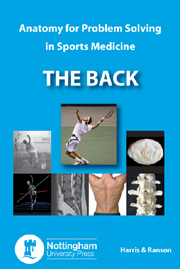Book contents
- Frontmatter
- Acknowledgements
- Foreword
- Contents
- Introduction
- Posture and Curvatures
- Vertebrae
- Spondylolysis and Spondylolisthesis
- Spinal Joints
- Anatomical Factors Influencing Spinal Nerve Compression By Intervertebral Discs
- Movements Of The Head and Spine
- Spinal Cord, Meninges and Spinal Nerves
- Muscles
- References
- Answers to Problems
- Index
Introduction
- Frontmatter
- Acknowledgements
- Foreword
- Contents
- Introduction
- Posture and Curvatures
- Vertebrae
- Spondylolysis and Spondylolisthesis
- Spinal Joints
- Anatomical Factors Influencing Spinal Nerve Compression By Intervertebral Discs
- Movements Of The Head and Spine
- Spinal Cord, Meninges and Spinal Nerves
- Muscles
- References
- Answers to Problems
- Index
Summary
Because of its unique position in the body as a result of man's upright posture the back is particularly vulnerable to stresses and strains. All components of the back including bones, joints, ligaments, muscles and nerves are susceptible to damage. In the western world, back pain is one of the biggest causes of lost working days. This is reflected even more in the athletic environment with back injury being a major cause of lost training and playing time across a variety of sports. The back is exposed to traumatic injury in activities involving the risk of extremely high forces such as motorsports, parachute sports, tackling football codes (Rugby and Rugby League, Australian and American Football) and maximal weight lifting. Acute muscle strain, ligament disruption and even fracture, joint dislocation and associated spinal cord or nerve injury may result. However, most incidences of back injury in sport are due to cumulative micro-trauma involving sustained or repeated stress applied to component tissues such as the trunk musculature, the inter-vertebral discs, the various joint complexes and the bony structure. For example, sports involving repeated or sustained trunk flexion, such as cycling and rowing (Perich et al., 2011), have high incidences of intervertebral disc related pain whilst sports involving repeated back extension (often combined with rotation and side-flexion) such as gymnastics, golf, throwing and cricket fast bowling (Ranson et al., 2010), butterfly and breaststroke swimming, have high rates of bony stress and zygapophyseal (facet) joint injury.
- Type
- Chapter
- Information
- Anatomy for Problem Solving in Sports MedicineThe Back, pp. 1Publisher: Nottingham University PressPrint publication year: 2012



